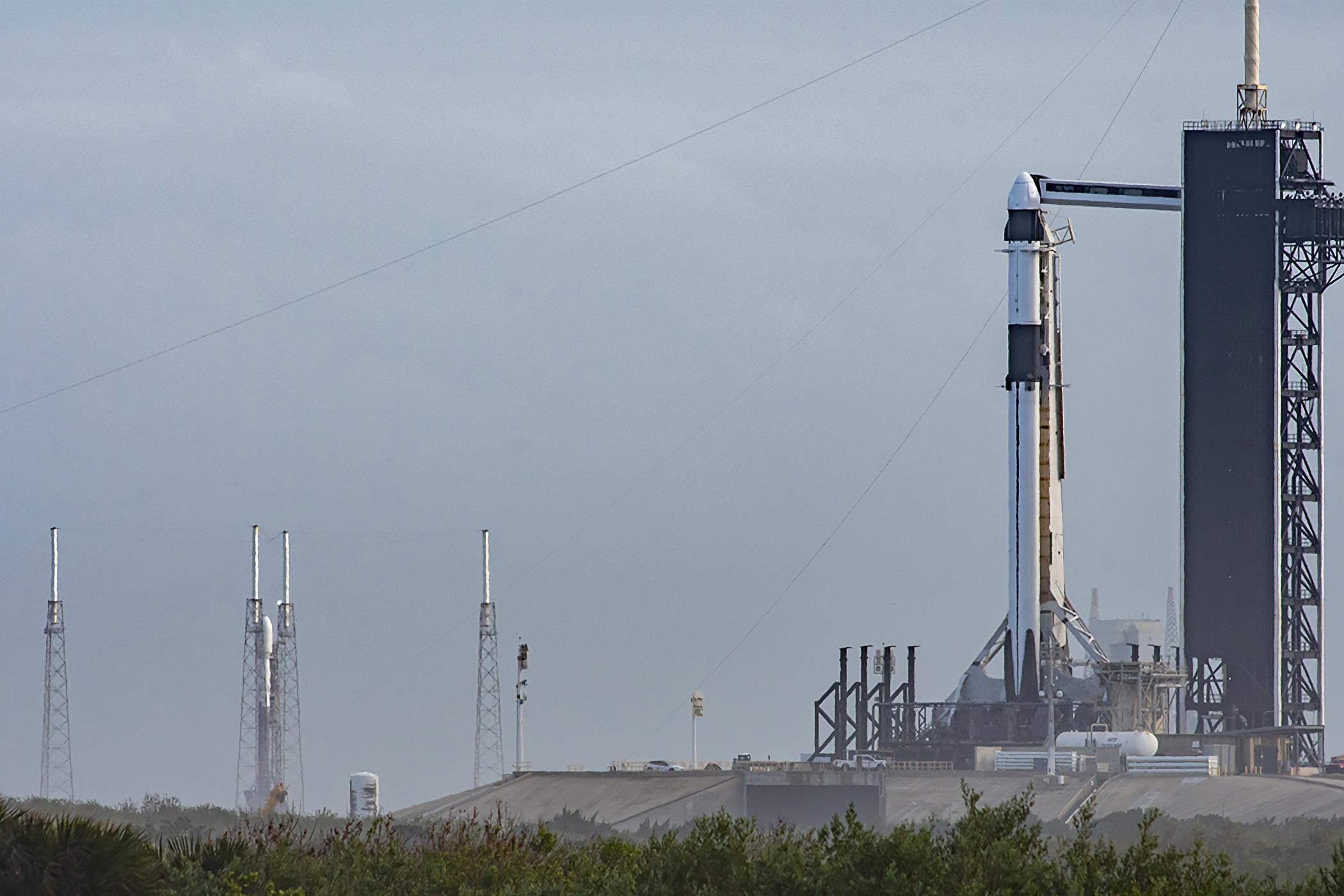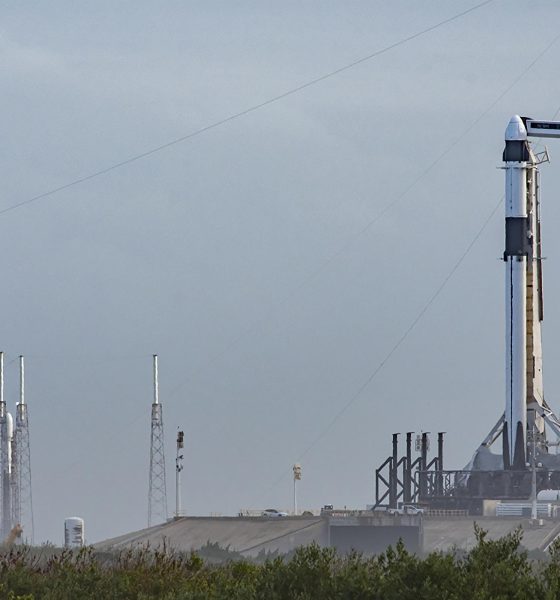

News
SpaceX doubleheader struck down by poor weather
Update: The first of two SpaceX launch attempts scheduled on Tuesday, November 22nd has been called off by poor weather. The weather for the second attempt, carrying a Eutelsat communications satellite, is expected to be just as poor, but SpaceX is still working towards a 9:57 pm EST (02:57 UTC) launch in spite of CRS-26’s bad luck.
SpaceX says it will attempt to launch two Falcon 9 rockets six hours apart after delaying a mission that was scheduled to lift off on November 21st.
The weather at Cape Canaveral is expected to be poor, with just a 10% chance of favorable conditions. But SpaceX says it will still attempt to launch the Eutelsat 10B communications satellite around 9:57 pm EST (2:57 UTC) on Tuesday, November 22nd, after delaying a November 21st attempt “to allow for additional pre-flight checkouts.” Only a few days prior, SpaceX indefinitely delayed a different Falcon 9 launch after apparently uncovering a problem during prelaunch testing. That problem was significant enough for SpaceX’s West Coast drone ship to return to port, guaranteeing a multi-day delay.
Despite back-to-back delays caused by apparent technical issues with two other Falcon 9 rockets, SpaceX’s next Cargo Dragon resupply mission to the International Space Station remains on track to launch as early as 3:54 pm EST (20:54 UTC) on November 22nd.
In the days prior, even Dragon’s CRS-26 mission didn’t escape unscathed. SpaceX discovered a small leak in the Dragon spacecraft earlier this month, forcing it to push the launch from November 21st to November 22nd. Before that, CRS-26 was delayed from November 18th to the 21st in the wake of Hurricane Nicole. Out of coincidence, the combination of the hurricane, Dragon leak, and unspecified issues with Eutelsat 10B’s rocket or payload have placed the launches just over six hours apart.
24 hours out, US Space Launch Delta 45 (formerly the 45th Space Wing) predicts just a 10% chance of favorable conditions for CRS-26 and Eutelsat 10B. The odds that both launches will thread a different 1-in-10 needle six hours apart are not great. Eutelsat 10B has a backup window on November 23rd with a 60% chance of favorable weather, while CRS-26’s next opportunity is November 26th.
CRS-26 will launch several thousand pounds of food, water, supplies, and a third set of upgraded solar arrays to the International Space Station (ISS). The mission will debut a new Falcon 9 booster (B1076) and the fourth and final reusable Cargo Dragon 2 spacecraft (Capsule C211).
In an unusual first, Eutelsat 10B will be the third SpaceX launch this month to intentionally expend a Falcon booster as Falcon 9 B1049 – the oldest in the fleet – flies its eleventh and final mission. The well-worn booster’s sacrifice will help boost the 5.5-ton (~12,000 lb) Eutelsat 10B communications satellite into a higher transfer orbit than usual, likely shaving weeks off the orbit-raising process and allowing it to enter service sooner. SpaceX will still attempt to recover Falcon 9’s payload fairing (nosecone) halves more than a thousand kilometers downrange.

Elon Musk
Elon Musk’s X will start using a Tesla-like software update strategy
The initiative seems designed to accelerate updates to the social media platform, while maintaining maximum transparency.

Elon Musk’s social media platform X will adopt a Tesla-esque approach to software updates for its algorithm.
The initiative seems designed to accelerate updates to the social media platform, while maintaining maximum transparency.
X’s updates to its updates
As per Musk in a post on X, the social media company will be making a new algorithm to determine what organic and advertising posts are recommended to users. These updates would then be repeated every four weeks.
“We will make the new 𝕏 algorithm, including all code used to determine what organic and advertising posts are recommended to users, open source in 7 days. This will be repeated every 4 weeks, with comprehensive developer notes, to help you understand what changed,” Musk wrote in his post.
The initiative somewhat mirrors Tesla’s over-the-air update model, where vehicle software is regularly refined and pushed to users with detailed release notes. This should allow users to better understand the details of X’s every update and foster a healthy feedback loop for the social media platform.
xAI and X
X, formerly Twitter, has been acquired by Elon Musk’s artificial intelligence startup, xAI last year. Since then, xAI has seen a rapid rise in valuation. Following the company’s the company’s upsized $20 billion Series E funding round, estimates now suggest that xAI is worth tens about $230 to $235 billion. That’s several times larger than Tesla when Elon Musk received his controversial 2018 CEO Performance Award.
As per xAI, the Series E funding round attracted a diverse group of investors, including Valor Equity Partners, Stepstone Group, Fidelity Management & Research Company, Qatar Investment Authority, MGX, and Baron Capital Group, among others. Strategic partners NVIDIA and Cisco Investments also continued support for building the world’s largest GPU clusters.
News
Tesla FSD Supervised wins MotorTrend’s Best Driver Assistance Award
The decision marks a notable reversal for the publication from prior years, with judges citing major real-world improvements that pushed Tesla’s latest FSD software ahead of every competing ADAS system.

Tesla’s Full Self-Driving (Supervised) system has been named the best driver-assistance technology on the market, earning top honors at the 2026 MotorTrend Best Tech Awards.
The decision marks a notable reversal for the publication from prior years, with judges citing major real-world improvements that pushed Tesla’s latest FSD software ahead of every competing ADAS system. And it wasn’t even close.
MotorTrend reverses course
MotorTrend awarded Tesla FSD (Supervised) its 2026 Best Tech Driver Assistance title after extensive testing of the latest v14 software. The publication acknowledged that it had previously criticized earlier versions of FSD for erratic behavior and near-miss incidents, ultimately favoring rivals such as GM’s Super Cruise in earlier evaluations.
According to MotorTrend, the newest iteration of FSD resolved many of those shortcomings. Testers said v14 showed far smoother behavior in complex urban scenarios, including unprotected left turns, traffic circles, emergency vehicles, and dense city streets. While the system still requires constant driver supervision, judges concluded that no other advanced driver-assistance system currently matches its breadth of capability.
Unlike rival systems that rely on combinations of cameras, radar, lidar, and mapped highways, Tesla’s FSD operates using a camera-only approach and is capable of driving on city streets, rural roads, and freeways. MotorTrend stated that pure utility, the ability to handle nearly all road types, ultimately separated FSD from competitors like Ford BlueCruise, GM Super Cruise, and BMW’s Highway Assistant.
High cost and high capability
MotorTrend also addressed FSD’s pricing, which remains significantly higher than rival systems. Tesla currently charges $8,000 for a one-time purchase or $99 per month for a subscription, compared with far lower upfront and subscription costs from other automakers. The publication noted that the premium is justified given FSD’s unmatched scope and continuous software evolution.
Safety remained a central focus of the evaluation. While testers reported collision-free operation over thousands of miles, they noted ongoing concerns around FSD’s configurable driving modes, including options that allow aggressive driving and speeds beyond posted limits. MotorTrend emphasized that, like all Level 2 systems, FSD still depends on a fully attentive human driver at all times.
Despite those caveats, the publication concluded that Tesla’s rapid software progress fundamentally reshaped the competitive landscape. For drivers seeking the most capable hands-on driver-assistance system available today, MotorTrend concluded Tesla FSD (Supervised) now stands alone at the top.
News
Elon Musk’s Grokipedia surges to 5.6M articles, almost 79% of English Wikipedia
The explosive growth marks a major milestone for the AI-powered online encyclopedia, which was launched by Elon Musk’s xAI just months ago.

Elon Musk’s Grokipedia has grown to an impressive 5,615,201 articles as of today, closing in on 79% of the English Wikipedia’s current total of 7,119,376 articles.
The explosive growth marks a major milestone for the AI-powered online encyclopedia, which was launched by Elon Musk’s xAI just months ago. Needless to say, it would only be a matter of time before Grokipedia exceeds English Wikipedia in sheer volume.
Grokipedia’s rapid growth
xAI’s vision for Grokipedia emphasizes neutrality, while Grok’s reasoning capabilities allow for fast drafting and fact-checking. When Elon Musk announced the initiative in late September 2025, he noted that Grokipedia would be an improvement to Wikipedia because it would be designed to avoid bias.
At the time, Musk noted that Grokipedia “is a necessary step towards the xAI goal of understanding the Universe.”
Grokipedia was launched in late October, and while xAI was careful to list it only as Version 0.1 at the time, the online encyclopedia immediately earned praise. Wikipedia co-founder Larry Sanger highlighted the project’s innovative approach, noting how it leverages AI to fill knowledge gaps and enable rapid updates. Netizens also observed how Grokipedia tends to present articles in a more objective manner compared to Wikipedia, which is edited by humans.
Elon Musk’s ambitious plans
With 5,615,201 total articles, Grokipedia has now grown to almost 79% of English Wikipedia’s article base. This is incredibly quick, though Grokipedia remains text-only for now. xAI, for its part, has now updated the online encyclopedia’s iteration to v0.2.
Elon Musk has shared bold ideas for Grokipedia, including sending a record of the entire knowledge base to space as part of xAI’s mission to preserve and expand human understanding. At some point, Musk stated that Grokipedia will be renamed to Encyclopedia Galactica, and it will be sent to the cosmos.
“When Grokipedia is good enough (long way to go), we will change the name to Encyclopedia Galactica. It will be an open source distillation of all knowledge, including audio, images and video. Join xAI to help build the sci-fi version of the Library of Alexandria!” Musk wrote, adding in a later post that “Copies will be etched in stone and sent to the Moon, Mars and beyond. This time, it will not be lost.”








